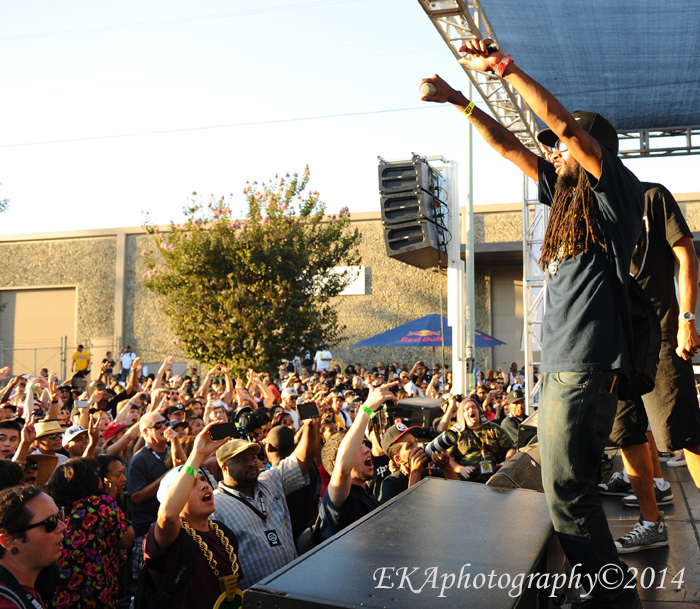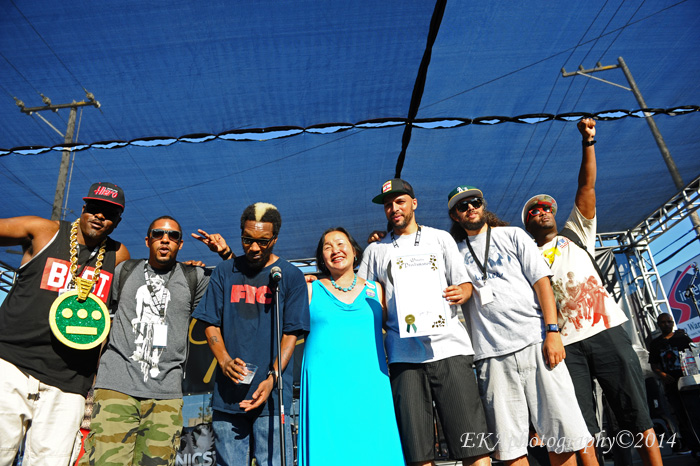Live music review/ Linden St. Brewery, 9/1/14. All photos © Eric K. Arnold/EKAphotography
Late Monday afternoon, after watching an unannounced surprise set by Deltron 3030, the alt-rap supergroup featuring Del the Funky Homosapien and Dan the Automator, Oakland Mayor Jean Quan read an official proclamation declaring “Hiero Day” on stage at the event of the same name, in front of a crowd of more than 22,000 hip-hop lovers and diehard fans of the Hieroglyphics. Quan’s reading of the proclamation may have been one of the few, if not only, times in recent memory when a major city’s top elected official embraced hip-hop culture as part of a community engagement strategy.
All eight members of the Hiero crew—founder Del, emcees Casual, Phesto Dee, Tajai, A-Plus, Opio, DJ Toure, and producer/ road manager Domino—beamed as Quan handed Domino a piece of paper, upon which, one imagines, suitably puissant and laudatory words were written. The gesture may have been symbolic, yet its meaning was magnified by the fact that 2,000 miles away, in Ferguson, Missouri, the aftermath of the Mike Brown police shooting had created a level of civil unrest which threatened to set the clock back to South Central Los Angeles, circa 1992, or perhaps Detroit, 1967 – an uncertain, volatile mix of racially-tinged cries for justice and equally racially-tinged clamors against looting, curfew-breaking, and civil disobedience.
Meanwhile, Oakland—a city not immune to protests against police hostility toward unarmed black men, a city which had marched for Trayvon Martin, as well as its own martyrs Alan Blueford, Oscar Grant, Derrick Jones, and Gary King—remained calm, if that word can be used to describe a boisterous yet well-mannered crowd who thrust 20,000+ three-fingered salutes into the air and smoked enough ganja to give the Mayor’s entire entourage a contact high.
For the mayor to co-sign on Hiero’s accomplishments was major; Politicians generally don’t openly acknowledge the positive contributions of hip-hop, or align themselves with rappers, since such approaches could be perceived as not being tough on crime. Yet crime is down in Oakland, without the mayor or local government resorting to such draconian measures as instituting a youth curfew.
Hip-hop often gets a bad rap because its practitioners tend to be young and black, even though its audience crosses all racial and ethnic lines. Historically, hip-hop concerts have been linked to violence ever since the infamous Run-DMC Long Beach show in 1986, and Oakland itself once declared a yearlong moratorium on rap shows after violent incidents at the Oakland Coliseum and the HJK Auditorium in 1989. The threat of riots breaking out has been used to justify cancellation of shows and tours, high insurance and security costs, and exorbitant ticket prices, and rap shows which do turn bad are sure to get extra media attention. Just a week prior, a local promoter had been murdered backstage at a Wiz Khalifa show in Mountain View, and a high-profile warrant served on rapper Young Jeezy and his entourage. Yet there was no heavy-handed police presence at Hiero Day, despite a crowd which had swelled by 50% since last year’s installment.
That there were no fights, no scuffles, no drama and no violence at an event attended by so many is a testament to Oakland’s native sons, whose three-eye logo is synonymous with authentic West Coast underground hip-hop. Hieroglyphics have always represented conscious hip-hop, albeit with gritty urban overtones which never quite sink into clichéd gangsterdom.
Hiero came up at a time when a tongue-twisting lyrical couplet was enough to confer cultural elite status, and for the past two decades, they’ve outlasted hundreds, if not thousands, of less high-brow rappers with a more simplistic focus on ghetto storytelling—without the conceptual narratives Hiero spin.
They’ve obviously remained relevant, as the hundreds of t-shirts emblazoned with their logo visible from the stage Monday afternoon attested; Many of Hiero Day’s attendees weren’t out of preschool when Hieroglyphics made their first appearance in 1992, on “Burnt,” a B-side of a Del tha Funkee Homosapien record. In fact, it’s difficult to name another non-mainstream hip-hop act whose fanbase spans such a wide demographic spectrum of listeners.
On Monday, Hiero performed several classics, among them “You Never Knew” and “Oakland Blackouts” from 1998’s Full Circle, and a mini-spotlight on Casual (in honor of the 20th anniversary of his 1993 debut Fear Itself), who tore through “I Didn’t Mean To Do It,” “Me-O-Mi-O” and “That’s How It Is.” Newer songs like “Gun Fever,” however, emphasized the fact that Hiero is no mere hip-hop oldies act.
The highlight of Hieroglyphics set, however, was another unannounced cameo appearance, this time by Goapele, whose regal presence all but confirmed her as the reigning queen of Oakland Soul.
Up until then, the male-dominated bill had been somewhat of a sword fight—a fact that didn’t go unnoticed in online forums in the days leading up to the event. While a valid case can be made that Oakland’s resident female emcees should have been represented in the festival’s lineup, there’s no taking away from the inspirational upliftment Goapele blessed the crowd with, appearing with Hiero on “Make Your Move,” then segueing into “Milk and Honey,” followed by her signature song, “Closer.”
That provided a high note which was only surpassed by the show-closing rendition of Souls of Mischief’s eternal classic, “93 Til infinity.” The chorus, “this is how we chill from 93 til…,” has become not just a mantra, but a truism for Hiero and their fans; no matter how many times one has heard it, the song never fails to take listeners to their happy place.
Hiero’s performance, overall, was like watching a well-oiled machine being revved up to maximum capacity. 20 years of rocking together onstage has created some tight-knit bonds between group members, and the show never felt like any one emcee wasn’t completely in sync with the rest of the crew; even Del’s streak of blonde hair in his natural—a la Wesley Snipes in “Demolition Man”l— didn’t prove too much of a distraction during other emcees’ verses. Up and coming artists would do well to study Hiero’s stage show as a textbook example of how it’s done.
Speaking of up and coming artists, Hiero Day offered a potpourri of flavors, from the intricate battle-raps and supreme fluidity of Locksmith and Planet Asia to Los Rakas’ vibrant Town variant on reggaeton to the Mystik Journeymen’s “underground as fuck” credo, to the Hydra-like mini-supergroup of Zion-I, the Grouch and Eligh – and dozens more I didn’t get to see because there were three stages, a high level of crowd density, and the laws of physics say you can only be in one place at one time.
The best part of Hiero Day was that it remained a free event. That’s right, free. While traffic flow could be improved, beer lines were reportedly horrendous, and there was a shortage of water (promoters only expected about 15,000-18,000 people), that’s just a tremendous achievement any way you slice it. Attendees came from as far as Los Angeles, Sacramento and Tahoe, and any destination event helps a city’s financial bottom line.
Furthermore, when you consider the high prices of music festival tickets, Hiero Day not only has the most bang for the buck of any local event, but leaves festival-goers more room in their wallets to buy merch, which in turn supports artists, musicians, small clothing companies, food vendors, entrepreneurs, and the list goes on.
In other words, Hiero Day is a huge win-win for the hip-hop community, but also, as the mayor made plain, for the city of Oakland.











Pingback: 2014: The Year in Oakulture | oakulture